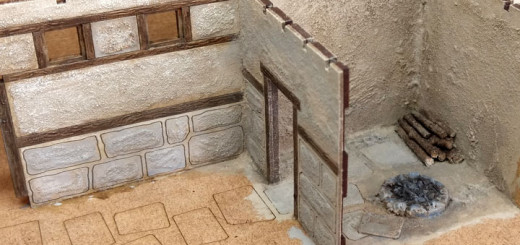10 : Finishing the Courtyard House
There wasn’t much more to do now to finish the courtyard house complex.

The buildings still needed roofs. I made a roof timber and a mud-roof piece for each of the three main buildings. These pieces were designed to be glued together in pairs but not to be glued to the buildings so that they could lift off during gameplay.

I made sure the kitchen roof had a smoke hole for the cooking fire. The hole would most likely have been square shaped as it would have been made between the roof timbers and strengthened by mud-bricks built up and stacked around it. The fibreboard mud-brick stack could have been left as it was but I decided to add grout filler to the sides and smooth it down – in this case rather irregularly as if it was a bit weathered.

The lean-to got a simple mud-roof glued on top of its existing roof timbers. I used a needle file to remove the sharp top edge of all the fibreboard mud-roofs. I also gave them all a wash of grout filler before painting.

When spreading grout over a model’s flat mud-roof – often with my fingers – I can’t but feel that I’m simply repeating the process in miniature that mud-brick builders employed and still employ today of plastering over their mud-brick builds. Unlike an actual builder, though, who is looking for a smooth finish, I’m trying to hint at some sort of weathering and enjoy adding the odd crack – a crack that may very well let rain water percolate into the joints if left unattended. Watch out, people of Troy!

I textured the base around the back of the house building. Because this was a lift-off model that wouldn’t be glued down, I took care not to add any grit where it would stand.

I added some more paving slabs cut from a cereal packet along the edge of the base at the front of the complex that might end up being the edge of a roadway. Painting the base was all done to match my tabletop.

It would be highly likely that a Bronze Age courtyard would have been used to keep livestock. Perhaps a chicken tied to a peg or a goat for milk. These animals would have been smaller and thinner than they are today but would have provided much-needed food over the winter months. It’s even probable that a household kept more than a few animals. Goats may have spent their nights in safety in the courtyard but taken out to graze the fields during the day. Animals would also have been brought into the courtyard in times of danger – a pretty good sign that battle is going on.

I set out to make a small-footprint Bronze Age homestead made up of a number of buildings built around a central courtyard. And here it is! All ready now for a 28mm Bronze Age household to move in.









RECENT COMMENTS